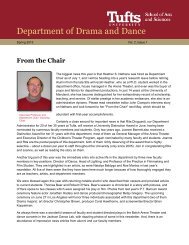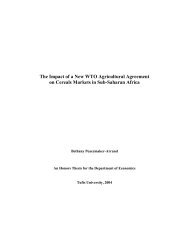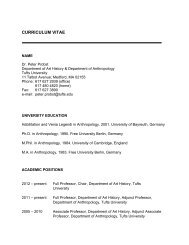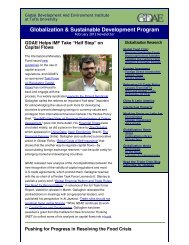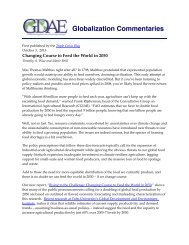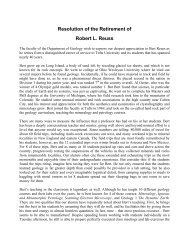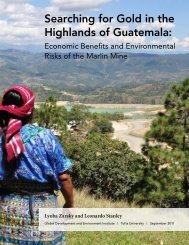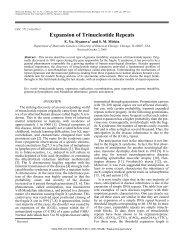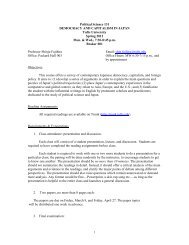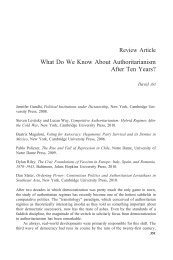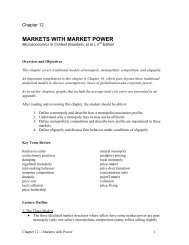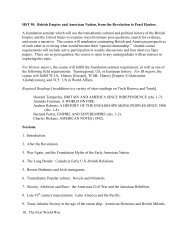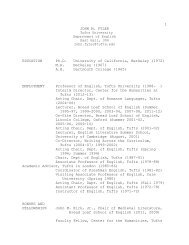Is A Main Street Program Appropriate for Mattapan? - Tufts University
Is A Main Street Program Appropriate for Mattapan? - Tufts University
Is A Main Street Program Appropriate for Mattapan? - Tufts University
Create successful ePaper yourself
Turn your PDF publications into a flip-book with our unique Google optimized e-Paper software.
CHaPTeR VI:<br />
loCal MaIn sTReeT<br />
D<strong>Is</strong>TRICTs InTeRVIeWs<br />
InTRoDUCTIon<br />
In an ef<strong>for</strong>t to learn more about the implementation of the <strong>Main</strong> <strong>Street</strong><br />
approach at the local level, we conducted interviews with nine executive<br />
directors from a number of Boston <strong>Main</strong> <strong>Street</strong>s districts . Each of the<br />
nineteen districts was contacted by both email and phone multiple times,<br />
but interviews were only completed with Mission Hill, East Boston, West<br />
Roxbury, St . Marks, Four Corners, Fields Corner, Upham’s Corner, Washington<br />
Gateway, and Hyde Park . A list of the interviewees and the questions<br />
asked can be found in the Appendix . In the following sections we will summarize<br />
our key findings, highlight the major themes that emerged from the<br />
interviews, and conclude with a brief look at the implementation possibilities<br />
in <strong>Mattapan</strong> .<br />
KeY fInDInGs<br />
A few key themes can be derived from our interviews with local <strong>Main</strong> <strong>Street</strong><br />
districts:<br />
• Funding will be a challenge - While the Boston <strong>Main</strong> <strong>Street</strong>s<br />
Foundation has been a welcome resurgence of capital, many<br />
executive directors spend the majority of their time trying to<br />
secure funding from businesses, grants, events, etc . One specific<br />
obstacle is competing with other non-profits that work with<br />
issues that are more immediate or ‘warm and fuzzy’ than neigh<br />
borhood revitalization . Another challenge is that small business<br />
owners may not have the money to donate or may not be con<br />
vinced of the benefits of working with <strong>Main</strong> <strong>Street</strong>s .<br />
• Reliance upon volunteers - This reliance was considered both a<br />
strength and a weakness . One executive director mentioned that<br />
volunteers are more enthusiastic than employees, plus you have<br />
the freedom to decide “what do we want to do in our neigh<br />
borhood?” Meanwhile another cites the particular difficulties of<br />
recruiting volunteers in low-income communities .<br />
• Lack of leadership/overcoming past issues - For the neighbor<br />
hoods of Upham’s Corner and Fields Corner, periods of stagna<br />
tion or poor leadership have left the present <strong>Main</strong> <strong>Street</strong> district<br />
having to spend time overcoming the community’s distrust in the<br />
abilities of the organization . A key ingredient to overcoming this<br />
is an executive director with a strong, visible presence in the<br />
26<br />
community .<br />
• Collaboration with organizations - Working with local organiza<br />
tions that complement the mission can be very advantageous,<br />
but <strong>Main</strong> <strong>Street</strong>s must remain focused on economic develop<br />
ment .<br />
• Outreach to the business community is challenging- Convinc<br />
ing business owners and property owners to be active partici<br />
pants in <strong>Main</strong> <strong>Street</strong>s will require special ef<strong>for</strong>ts . In walking the<br />
streets and making personal contact, collaborating with business<br />
organizations, hosting networking breakfasts or providing adver<br />
tising can help pull business owners in .<br />
• Public safety- Nearly all the <strong>Main</strong> <strong>Street</strong> districts mentioned the<br />
need to have a strong collaboration with the police department in<br />
the area .<br />
• Small things can be a big challenge- Because the <strong>Main</strong> <strong>Street</strong><br />
programs are typically run by one person, simple tasks can<br />
become complicated . <strong>Is</strong>sues of having to send mailings to two<br />
zip codes or simply conducting a survey (when the local popula<br />
tion speaks five different languages) become quite difficult .<br />
• Stick to the mission while making visible improvements- Local<br />
districts need to focus on visible projects- such as cultural<br />
events or store improvements, while also working towards the<br />
overall goal of district revitalization . The community must see<br />
that the executive director is out there doing things . Establishing<br />
a strong relationship with the media was highlighted as a key<br />
tool .<br />
MaJoR THeMes<br />
For the most part, the interviews solidified many findings presented in the<br />
previous chapter . Most interviewees talked about the difficulties of reaching<br />
out to merchants and the challenge of fundraising . For a few districts,<br />
the demographics of the population or historical conflicts posed challenges<br />
while others were able to capitalize by working with community organizations<br />
. Nearly every interview echoed the importance of keeping community<br />
support by making visible improvements . Long-term projects can be<br />
successful but only if they stay within the mission while also simultaneously<br />
working on smaller, visible initiatives . For a few districts, the location and<br />
demographics of the neighborhood, such as East Boston, West Roxbury,<br />
and Washington Gateway may not be applicable to <strong>Mattapan</strong> . While this<br />
may be the case, there still emerged several themes that were consistent<br />
throughout the interviews .




